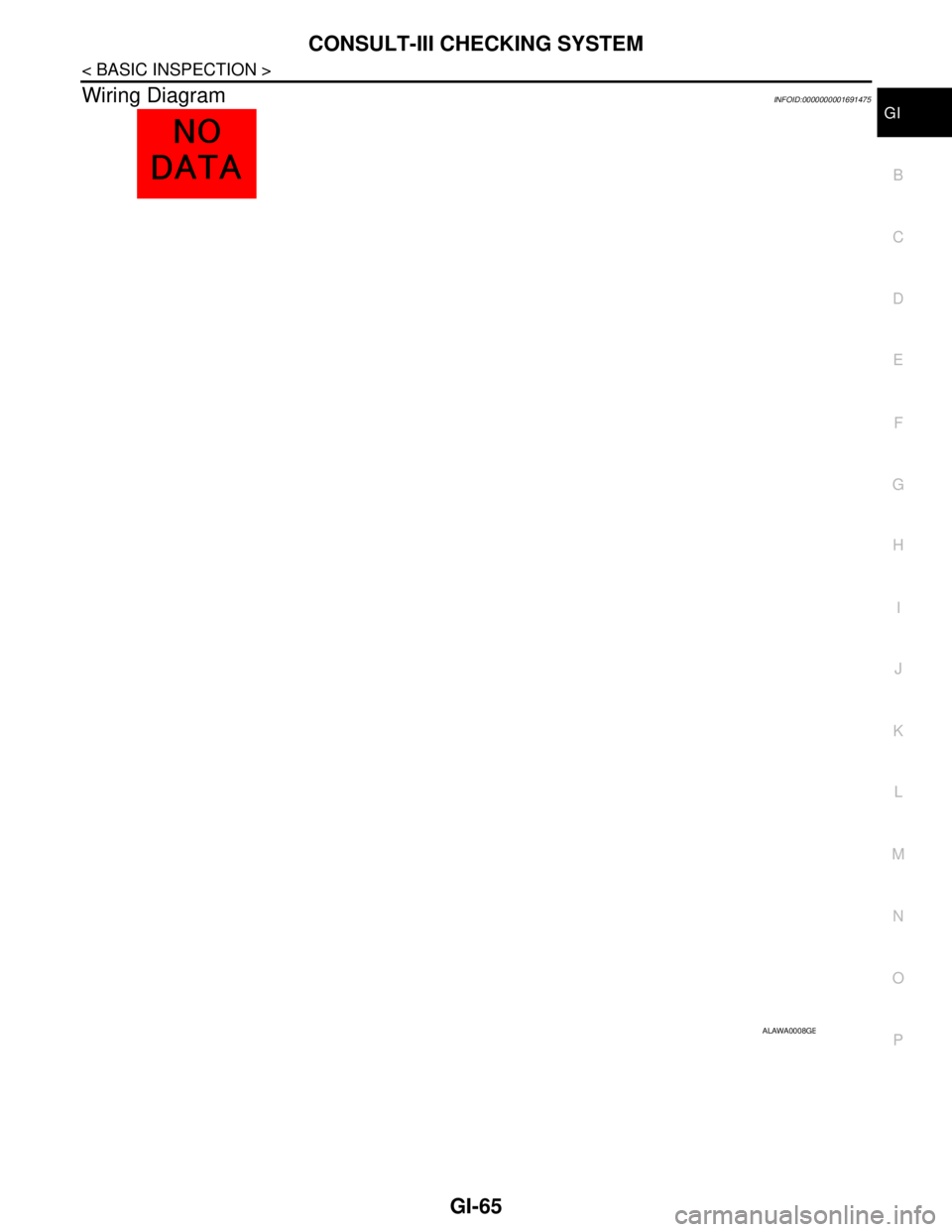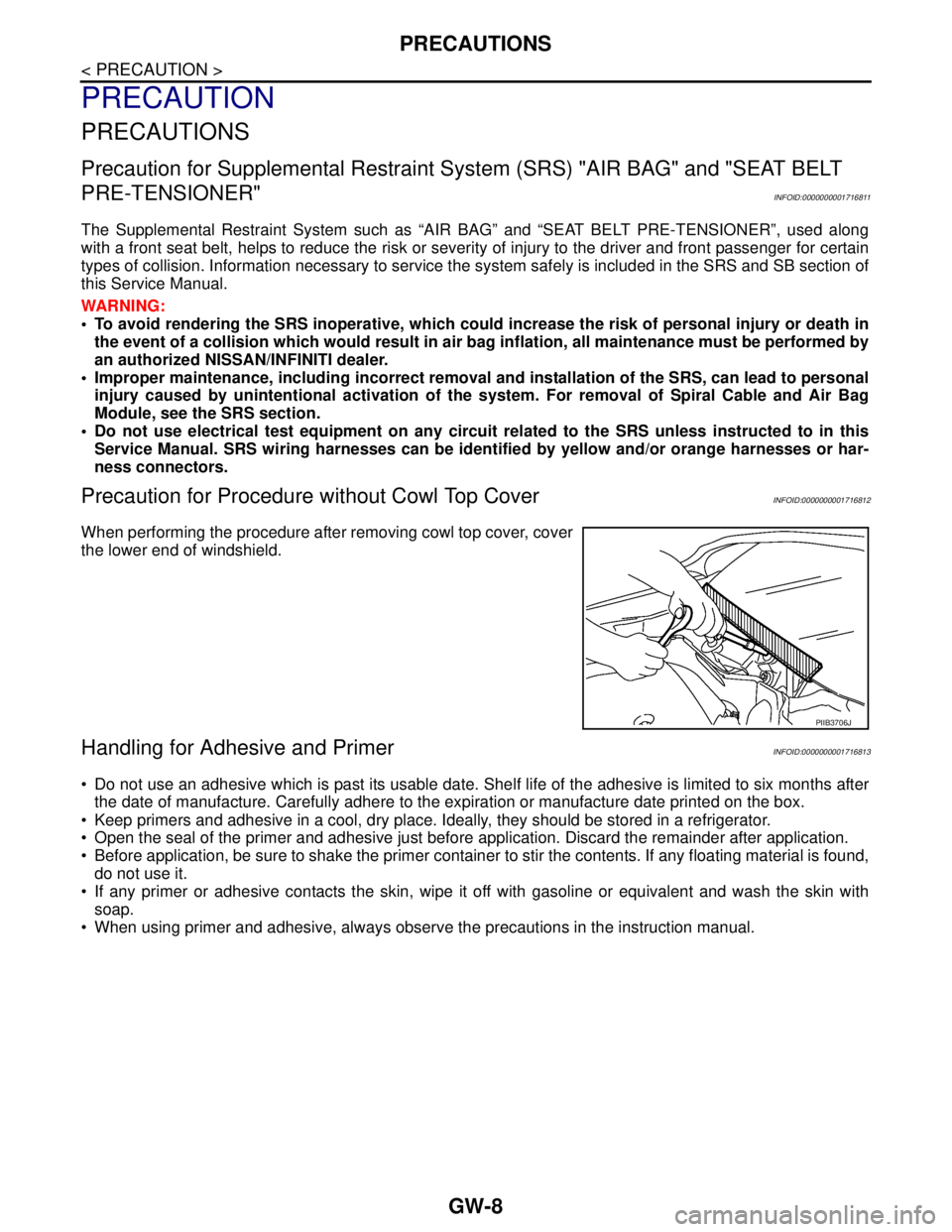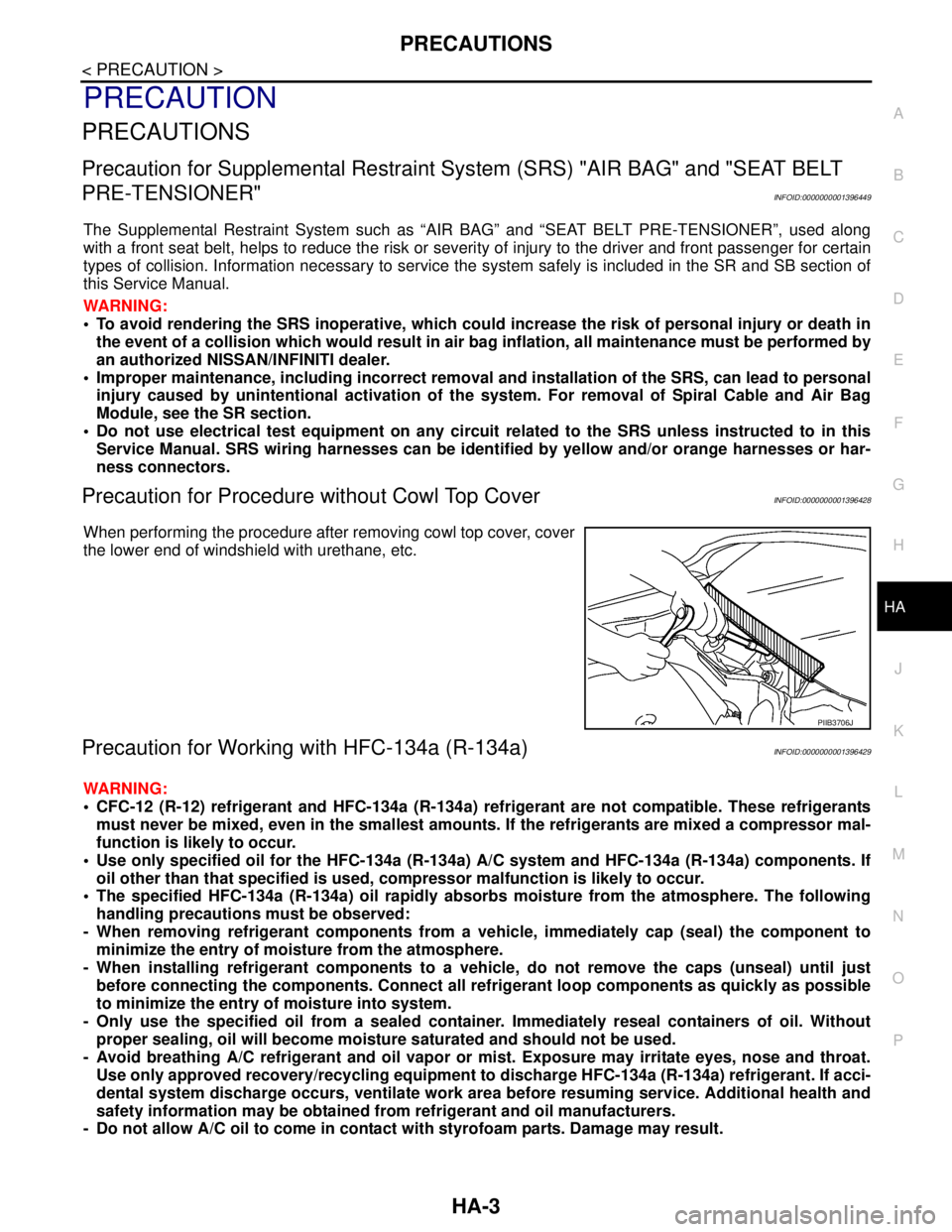2007 NISSAN TIIDA wiring
[x] Cancel search: wiringPage 3258 of 5883

GI-64
< BASIC INSPECTION >
CONSULT-III CHECKING SYSTEM
*1: With Intelligent Key System.
*2: With automatic transmission.
*3: Without Intelligent Key System.
CONSULT-III Data Link Connector (DLC) CircuitINFOID:0000000001691474
INSPECTION PROCEDURE
If the CONSULT-III cannot diagnose the system properly, check the following items.
NOTE:
The CAN and DDL2 circuits from DLC pins 6, 7 and 14 may be connected to more than one system. A short in
any circuit connected to a control unit in one system may affect CONSULT-III access to other systems.
Symptom Check item
CONSULT-III cannot access
any system. CONSULT-III DLC power supply circuit (Terminal 8) and ground circuit (Terminal 4)
CONSULT-III cannot access in-
dividual system. (Other sys-
tems can be accessed.) Power supply and ground circuit for the control unit of the system (For detailed circuit, refer to wiring
diagram for each system.)
Open or short circuit between the system and CONSULT-III DLC (For detailed circuit, refer to wiring
diagram for each system.)
Open or short circuit CAN communication line. Refer to LAN-22, "
Trouble Diagnosis Flow Chart".
Page 3259 of 5883

CONSULT-III CHECKING SYSTEM
GI-65
< BASIC INSPECTION >
C
D
E
F
G
H
I
J
K
L
MB
GI
N
O
P
Wiring DiagramINFOID:0000000001691475
ALAWA0008GB
Page 3263 of 5883

GW-4
< SYMPTOM DIAGNOSIS >
SQUEAK AND RATTLE TROUBLE DIAGNOSES
68370-4B000: 15×25 mm (0.59×0.98 in) pad/68239-13E00: 5 mm (0.20 in) wide tape roll. The following
materials not found in the kit can also be used to repair squeaks and rattles.
UHMW (TEFLON) TAPE
Insulates where slight movement is present. Ideal for instrument panel applications.
SILICONE GREASE
Used instead of UHMW tape that will be visible or not fit.
Note: Will only last a few months.
SILICONE SPRAY
Use when grease cannot be applied.
DUCT TAPE
Use to eliminate movement.
CONFIRM THE REPAIR
Confirm that the cause of a noise is repaired by test driving the vehicle. Operate the vehicle under the same
conditions as when the noise originally occurred. Refer to the notes on the Diagnostic Worksheet.
Generic Squeak and Rattle TroubleshootingINFOID:0000000001716816
Refer to Table of Contents for specific component removal and installation information.
INSTRUMENT PANEL
Most incidents are caused by contact and movement between:
1. The cluster lid A and instrument panel
2. Acrylic lens and combination meter housing
3. Instrument panel to front pillar garnish
4. Instrument panel to windshield
5. Instrument panel mounting pins
6. Wiring harnesses behind the combination meter
7. A/C defroster duct and duct joint
These incidents can usually be located by tapping or moving the components to duplicate the noise or by
pressing on the components while driving to stop the noise. Most of these incidents can be repaired by apply-
ing felt cloth tape or silicone spray (in hard to reach areas). Urethane pads can be used to insulate wiring har-
ness.
CAUTION:
Do not use silicone spray to isolate a squeak or rattle. If you saturate the area with silicone, you will
not be able to recheck the repair.
CENTER CONSOLE
Components to pay attention to include:
1. Shifter assembly cover to finisher
2. A/C control unit and cluster lid C
3. Wiring harnesses behind audio and A/C control unit
The instrument panel repair and isolation procedures also apply to the center console.
DOORS
Pay attention to the:
1. Finisher and inner panel making a slapping noise
2. Inside handle escutcheon to door finisher
3. Wiring harnesses tapping
4. Door striker out of alignment causing a popping noise on starts and stops
Tapping or moving the components or pressing on them while driving to duplicate the conditions can isolate
many of these incidents. You can usually insulate the areas with felt cloth tape or insulator foam blocks from
the NISSAN Squeak and Rattle Kit (J-43980) to repair the noise.
TRUNK
Trunk noises are often caused by a loose jack or loose items put into the trunk by the owner.
In addition look for:
1. Trunk lid bumpers out of adjustment
Page 3267 of 5883

GW-8
< PRECAUTION >
PRECAUTIONS
PRECAUTION
PRECAUTIONS
Precaution for Supplemental Restraint System (SRS) "AIR BAG" and "SEAT BELT
PRE-TENSIONER"
INFOID:0000000001716811
The Supplemental Restraint System such as “AIR BAG” and “SEAT BELT PRE-TENSIONER”, used along
with a front seat belt, helps to reduce the risk or severity of injury to the driver and front passenger for certain
types of collision. Information necessary to service the system safely is included in the SRS and SB section of
this Service Manual.
WARNING:
• To avoid rendering the SRS inoperative, which could increase the risk of personal injury or death in
the event of a collision which would result in air bag inflation, all maintenance must be performed by
an authorized NISSAN/INFINITI dealer.
Improper maintenance, including incorrect removal and installation of the SRS, can lead to personal
injury caused by unintentional activation of the system. For removal of Spiral Cable and Air Bag
Module, see the SRS section.
Do not use electrical test equipment on any circuit related to the SRS unless instructed to in this
Service Manual. SRS wiring harnesses can be identified by yellow and/or orange harnesses or har-
ness connectors.
Precaution for Procedure without Cowl Top CoverINFOID:0000000001716812
When performing the procedure after removing cowl top cover, cover
the lower end of windshield.
Handling for Adhesive and PrimerINFOID:0000000001716813
Do not use an adhesive which is past its usable date. Shelf life of the adhesive is limited to six months after
the date of manufacture. Carefully adhere to the expiration or manufacture date printed on the box.
Keep primers and adhesive in a cool, dry place. Ideally, they should be stored in a refrigerator.
Open the seal of the primer and adhesive just before application. Discard the remainder after application.
Before application, be sure to shake the primer container to stir the contents. If any floating material is found,
do not use it.
If any primer or adhesive contacts the skin, wipe it off with gasoline or equivalent and wash the skin with
soap.
When using primer and adhesive, always observe the precautions in the instruction manual.
PIIB3706J
Page 3285 of 5883

PRECAUTIONS
HA-3
< PRECAUTION >
C
D
E
F
G
H
J
K
L
MA
B
HA
N
O
P
PRECAUTION
PRECAUTIONS
Precaution for Supplemental Restraint System (SRS) "AIR BAG" and "SEAT BELT
PRE-TENSIONER"
INFOID:0000000001396449
The Supplemental Restraint System such as “AIR BAG” and “SEAT BELT PRE-TENSIONER”, used along
with a front seat belt, helps to reduce the risk or severity of injury to the driver and front passenger for certain
types of collision. Information necessary to service the system safely is included in the SR and SB section of
this Service Manual.
WARNING:
• To avoid rendering the SRS inoperative, which could increase the risk of personal injury or death in
the event of a collision which would result in air bag inflation, all maintenance must be performed by
an authorized NISSAN/INFINITI dealer.
Improper maintenance, including incorrect removal and installation of the SRS, can lead to personal
injury caused by unintentional activation of the system. For removal of Spiral Cable and Air Bag
Module, see the SR section.
Do not use electrical test equipment on any circuit related to the SRS unless instructed to in this
Service Manual. SRS wiring harnesses can be identified by yellow and/or orange harnesses or har-
ness connectors.
Precaution for Procedure without Cowl Top CoverINFOID:0000000001396428
When performing the procedure after removing cowl top cover, cover
the lower end of windshield with urethane, etc.
Precaution for Working with HFC-134a (R-134a)INFOID:0000000001396429
WARNING:
CFC-12 (R-12) refrigerant and HFC-134a (R-134a) refrigerant are not compatible. These refrigerants
must never be mixed, even in the smallest amounts. If the refrigerants are mixed a compressor mal-
function is likely to occur.
Use only specified oil for the HFC-134a (R-134a) A/C system and HFC-134a (R-134a) components. If
oil other than that specified is used, compressor malfunction is likely to occur.
The specified HFC-134a (R-134a) oil rapidly absorbs moisture from the atmosphere. The following
handling precautions must be observed:
- When removing refrigerant components from a vehicle, immediately cap (seal) the component to
minimize the entry of moisture from the atmosphere.
- When installing refrigerant components to a vehicle, do not remove the caps (unseal) until just
before connecting the components. Connect all refrigerant loop components as quickly as possible
to minimize the entry of moisture into system.
- Only use the specified oil from a sealed container. Immediately reseal containers of oil. Without
proper sealing, oil will become moisture saturated and should not be used.
- Avoid breathing A/C refrigerant and oil vapor or mist. Exposure may irritate eyes, nose and throat.
Use only approved recovery/recycling equipment to discharge HFC-134a (R-134a) refrigerant. If acci-
dental system discharge occurs, ventilate work area before resuming service. Additional health and
safety information may be obtained from refrigerant and oil manufacturers.
- Do not allow A/C oil to come in contact with styrofoam parts. Damage may result.
PIIB3706J
Page 3334 of 5883

HAC-1
VENTILATION, HEATER & AIR CONDITIONER
C
D
E
F
G
H
J
K
L
M
SECTION HAC
A
B
HAC
N
O
P
CONTENTS
HEATER & AIR CONDITIONING CONTROL SYSTEM
MANUAL AIR CONDITIONER
BASIC INSPECTION ....................................
5
DIAGNOSIS AND REPAIR WORKFLOW ..........5
How to Perform Trouble Diagnosis For Quick and
Accurate Repair ........................................................
5
INSPECTION AND ADJUSTMENT .....................6
Operational Check ....................................................6
FUNCTION DIAGNOSIS ...............................8
FUNCTION INFORMATION ................................8
Component Part Location .........................................8
REFRIGERATION SYSTEM ..............................10
Refrigerant Cycle ....................................................10
Refrigerant System Protection ................................10
AIR CONDITIONER CONTROL .........................11
System Diagram ......................................................11
System Description .................................................11
Discharge Air Flow ..................................................11
Switches And Their Control Function ......................12
Component Description ...........................................13
CAN COMMUNICATION SYSTEM ....................14
System Description .................................................14
DIAGNOSIS SYSTEM (BCM) ............................15
CONSULT-III Function (BCM) .................................15
COMPONENT DIAGNOSIS .........................16
MODE DOOR .....................................................16
Mode Door Diagnostic Procedure ...........................16
AIR MIX DOOR ...................................................17
Air Mix Door Diagnostic Procedure .........................17
INTAKE DOOR ...................................................18
Intake Door Diagnostic Procedure ..........................18
BLOWER MOTOR ............................................19
Front Blower Motor Component Function Check ....19
Front Blower Motor Diagnosis Procedure ................19
MAGNET CLUTCH ...........................................23
System Description ..................................................23
Magnet Clutch Component Function Check ............23
Magnet Clutch Diagnosis Procedure .......................24
INTAKE SENSOR .............................................30
Component Inspection .............................................30
Intake Sensor Diagnosis Procedure ........................30
Intake Sensor Component Inspection .....................31
PTC HEATER CONTROL SYSTEM .................33
PTC HEATER (300 WATT) ........................................33
PTC HEATER (300 WATT) : PTC Heater System
Description ...............................................................
33
PTC HEATER (300 WATT) : PTC Heater Compo-
nent Description .......................................................
34
PTC HEATER (300 WATT) : PTC Heater (300
Watt) Diagnosis Procedure ......................................
35
PTC HEATER (300 WATT) : PTC Heater (300
Watt) Component Inspection ...................................
41
PTC HEATER (1500 WATT) ......................................43
PTC HEATER (1500 WATT) : System Description ....43
PTC HEATER (1500 WATT) : Component De-
scription ...................................................................
44
PTC HEATER (1500 WATT) : PTC Heater (1500
Watt) Diagnosis Procedure ......................................
45
PTC HEATER (1500 WATT) : PTC Heater (1500
Watt) Component Inspection ...................................
50
ECU DIAGNOSIS .........................................53
AIR CONDITIONER CONTROL ........................53
Reference Value ......................................................53
Wiring Diagram - Heater Control (without A/C) - .....54
Wiring Diagram - Air Conditioner Control - ..............56
Page 3335 of 5883

HAC-2
PTC HEATER CONTROL SYSTEM ..................63
PTC HEATER (300 WATT) .......................................63
PTC HEATER (300 WATT) : Wiring Diagram -
PTC Heater (300 Watt) - .........................................
63
PTC HEATER (1500 WATT) .....................................67
PTC HEATER (1500 WATT) : Wiring Diagram -
PTC Heater (1500 Watt) - .......................................
68
SYMPTOM DIAGNOSIS .............................72
AIR CONDITIONER CONTROL ........................72
Symptom Matrix Chart ..........................................72
INSUFFICIENT COOLING .................................73
Component Function Check ...................................73
Performance Test Diagnoses .................................74
Performance Chart .................................................75
Test Reading ..........................................................76
Trouble Diagnoses for Unusual Pressure ...............77
INSUFFICIENT HEATING .................................81
Component Function Check ...................................81
NOISE ................................................................83
Component Function Check ...................................83
PRECAUTION .............................................84
PRECAUTIONS .................................................84
Precaution for Supplemental Restraint System
(SRS) "AIR BAG" and "SEAT BELT PRE-TEN-
SIONER" .................................................................
84
Precaution for Procedures Without Cowl Top Cov-
er ............................................................................
84
Working with HFC-134a (R-134a) ..........................84
Precaution for Service Equipment ..........................85
AUTO AIR CONDITIONER (W/O NAVI)
BASIC INSPECTION ...................................
86
DIAGNOSIS AND REPAIR WORKFLOW .........86
How to Perform Trouble Diagnosis For Quick And
Accurate Repair ......................................................
86
INSPECTION AND ADJUSTMENT ...................87
Operational Check ..................................................87
FUNCTION DIAGNOSIS .............................89
FUNCTION INFORMATION ..............................89
Component Part Location .......................................89
REFRIGERATION SYSTEM ..............................91
Refrigerant Cycle ....................................................91
Refrigerant System Protection ................................91
AUTOMATIC AIR CONDITIONER SYSTEM .....92
Control System Diagram ........................................92
Control System Description ....................................92
Discharge Air Flow .................................................94
Switches And Their Control Function ......................95
CAN COMMUNICATION SYSTEM ...................96
System Description .................................................96
DIAGNOSIS SYSTEM (BCM) ............................97
CONSULT-III Function (BCM) ................................97
SELF-DIAGNOSIS FUNCTION .........................98
Front Air Control Self-Diagnosis .............................98
A/C System Self-Diagnosis Code Chart ...............104
COMPONENT DIAGNOSIS ......................106
MODE DOOR MOTOR .....................................106
System Description ...............................................106
Mode Door Motor Component Function Check ....107
Mode Door Motor Diagnosis Procedure ................109
AIR MIX DOOR MOTOR ..................................110
System Description ...............................................110
Air Mix Door Motor Component Function Check ..111
Air Mix Door Motor Diagnosis Procedure ..............112
INTAKE DOOR MOTOR ...................................114
System Description ...............................................114
Intake Door Motor Component Function Check ....115
Intake Door Motor Diagnosis Procedure ...............116
BLOWER MOTOR CONTROL SYSTEM .........118
System Description ...............................................118
Front Blower Motor Component Function Check ..119
Front Blower Motor Diagnosis Procedure .............120
Front Blower Motor Component Inspection ..........123
MAGNET CLUTCH ...........................................124
System Description ...............................................124
Magnet Clutch Component Function Check .........124
Magnet Clutch Diagnosis Procedure ....................125
AMBIENT SENSOR ..........................................130
Component Description ........................................130
Ambient Sensor Diagnosis Procedure ..................130
Ambient Sensor Component Inspection ...............131
IN-VEHICLE SENSOR ......................................133
Component Description ........................................133
In-Vehicle Sensor Diagnosis Procedure ...............133
In-Vehicle Sensor Component Inspection .............135
SUNLOAD SENSOR ........................................136
System Description ...............................................136
Sunload Sensor Diagnosis Procedure ..................136
Sunload Component Inspection ............................137
INTAKE SENSOR .............................................139
Component Inspection ..........................................139
Intake Sensor Diagnosis Procedure .....................139
Intake Sensor Component Inspection ...................140
PTC HEATER CONTROL SYSTEM .................142
Page 3336 of 5883

HAC-3
C
D
E
F
G
H
J
K
L
MA
B
HAC
N
O
P PTC HEATER (300 WATT) .....................................
142
PTC HEATER (300 WATT) : PTC Heater System
Description ............................................................
142
PTC HEATER (300 WATT) : PTC Heater Compo-
nent Description ....................................................
143
PTC HEATER (300 WATT) : PTC Heater (300
Watt) Diagnosis Procedure ...................................
144
PTC HEATER (300 WATT) : PTC Heater (300
Watt) Component Inspection .................................
151
PTC HEATER (1500 WATT) ...................................153
PTC HEATER (1500 WATT) : System Description ..153
PTC HEATER (1500 WATT) : Component De-
scription .................................................................
154
PTC HEATER (1500 WATT) : PTC Heater (1500
Watt) Diagnosis Procedure ...................................
155
PTC HEATER (1500 WATT) : PTC Heater (1500
Watt) Component Inspection .................................
160
POWER SUPPLY AND GROUND CIRCUIT
FOR CONTROLLER ........................................
163
Component Description .........................................163
Front Air Control Component Function Check ......163
Front Air Control Power and Ground Diagnosis
Procedure ..............................................................
163
ECU DIAGNOSIS .......................................165
AIR CONDITIONER CONTROL .......................165
Front Air Control Terminals Reference Values .....165
Wiring Diagram - Air Conditioner Control - ............167
PTC HEATER CONTROL SYSTEM ................175
PTC HEATER (300 WATT) .....................................175
PTC HEATER (300 WATT) : Wiring Diagram -
PTC Heater (300 Watt) - .......................................
175
PTC HEATER (1500 WATT) ...................................179
PTC HEATER (1500 WATT) : Wiring Diagram -
PTC Heater (1500 Watt) - .....................................
180
SYMPTOM DIAGNOSIS ............................184
AIR CONDITIONER CONTROL .......................184
Symptom Matrix Chart .........................................184
INSUFFICIENT COOLING ...............................185
Component Function Check ..................................185
Performance Test Diagnoses ................................186
Performance Chart ................................................188
Test Reading .........................................................189
Trouble Diagnoses for Unusual Pressure .............189
INSUFFICIENT HEATING ................................193
Component Function Check ..................................193
NOISE ...............................................................195
Component Function Check ..................................195
SELF-DIAGNOSIS CANNOT BE PER-
FORMED ..........................................................
197
Self-Diagnosis .......................................................197
MEMORY FUNCTION DOES NOT OPERATE .198
Memory Function Check ........................................198
PRECAUTION ............................................199
PRECAUTIONS ...............................................199
Precaution for Supplemental Restraint System
(SRS) "AIR BAG" and "SEAT BELT PRE-TEN-
SIONER" ...............................................................
199
Precaution for Procedures Without Cowl Top Cov-
er ...........................................................................
199
Working with HFC-134a (R-134a) .........................199
Precaution for Service Equipment .........................200
AUTO AIR CONDITIONER (W/NAVI)
BASIC INSPECTION .................................
201
DIAGNOSIS AND REPAIR WORKFLOW ......201
How to Perform Trouble Diagnosis For Quick And
Accurate Repair .....................................................
201
INSPECTION AND ADJUSTMENT ................202
Operational Check .................................................202
FUNCTION DIAGNOSIS ............................204
FUNCTION INFORMATION ............................204
Component Part Location ......................................204
REFRIGERATION SYSTEM ...........................206
Refrigerant Cycle ...................................................206
Refrigerant System Protection ...............................206
AUTOMATIC AIR CONDITIONER SYSTEM ..207
Control System Diagram .......................................207
Control System Description ...................................207
Discharge Air Flow ................................................208
Switches And Their Control Function ....................209
CAN COMMUNICATION SYSTEM .................211
System Description ................................................211
DIAGNOSIS SYSTEM (BCM) .........................212
CONSULT-III Function (BCM) ...............................212
SELF-DIAGNOSIS FUNCTION .......................213
Front Air Control Self-Diagnosis ............................213
Front Air Control Self-Diagnosis Code Chart .........218
COMPONENT DIAGNOSIS .......................219
MODE DOOR MOTOR ....................................219
System Description ................................................219
Mode Door Motor Component Function Check .....220
Mode Door Motor Diagnosis Procedure ................222
AIR MIX DOOR MOTOR .................................224
System Description ................................................224
Air Mix Door Motor Component Function Check ...225
Air Mix Door Motor Diagnosis Procedure ..............226